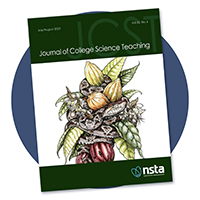Author Guidelines
Journal of College Science Teaching

Journal of College Science Teaching
The Journal of College Science Teaching is an award-winning, peer-reviewed, practitioners’ journal. Subscribers are members of the National Science Teaching Association who select it as their preferred journal. We hope you will consider writing a manuscript for JCST.
Questions?
Contact managing editor Caroline Barnes
Audience
-
University faculty
-
State and district supervisors and leaders
Schedule
Six issues per year
Formats
e-journal
Your Manuscript
See our detailed manuscript preparation guidelines.
Create
Create a Manuscript
We seek manuscripts that share ideas on and experiences with undergraduate science courses, particularly those for non-science majors. JCST also reports and discusses innovative teaching materials, methods, and evaluative criteria; disseminates contributions toward improving college science instruction; and describes work in disciplinary science courses that is broad enough in its approach to appeal to teachers in other scientific fields.
Manuscript Presentation
Your manuscript should:
-
not exceed 3,000 words (4,000 words for Research and Teaching column). Longer manuscripts may be returned for revision without being reviewed.
-
be written clearly and concisely with an introduction and conclusion.
-
stress interdisciplinary aspects of science teaching.
-
use SI (metric) units throughout the article.
-
have tables, graphs, and charts appropriately labeled.
-
acknowledge financial support for work reported at the end of the manuscript.
-
follow APA, 7th edition: References within the text should cite in parentheses the author’s name and year of publication; for three or more authors, the first author’s last name and “et al.” is used for the in-text citation. The full citation should be included alphabetically by author’s last name in a Reference list at the end of the article.
Photographs and Illustrations
To facilitate the review process, you’ll need to submit a single, complete file. Consequently, any graphics that you would like to submit, such as figures, tables, photos, and illustrations, should be included at the end of the text file. To minimize the size of the file, you can embed low-resolution images in the file. However, we will need you to submit high-resolution versions of the figures for use by the journal if your manuscript is accepted for publication. Please submit jpeg or tiff files of the figures, with at least 300 dpi resolution.
Students in laboratory settings must be shown following appropriate safety guidelines and wearing proper safety attire, including full-wrap, splash-proof goggles. Their faces should be visible, but they should not look directly at the camera. If the photo is used, a signed model release will be required of each student pictured.
Questions?
If you have any questions about the submission process, please contact the JCST editor by email.
Caroline Barnes, Managing Editor


